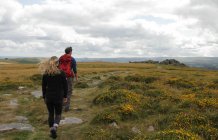
Photo: Dartmoor National Park Authority
Dartmoor National Park prepares for population rise
Dartmoor National Park Authority has released details of a new study, undertaken with academics from the University of Exeter, looking into the possible affects and opportunities of a growing local population in surrounding areas on the special qualities of the National Park.
The Authority has been working closely with academics from the University of Exeter’s SWEEP project to compile a report that examines how new housing developments and a rising population may affect Dartmoor over the next 25 years.
The report highlights the importance of Dartmoor for access to the outdoors. Remarkably, nearly a third (30%) of all visits are “unique” to Dartmoor, meaning that without the National Park the visitor would not have taken part in any outdoor activity (such as walking or cycling) elsewhere.
This innovative project has, for the first time, brought together data on population growth and leisure-time trends, and compared it with information on key wildlife species and habitats. The research team have calculated where and how far future visitors are likely to travel, and predicted what this will mean for sites across Dartmoor, looking at issues such as footpath erosion and disturbance to important wildlife.
Combining data from national population projections and local housing plans, the report forecasts that the number of people living in and around Dartmoor is set to increase by 13 per cent between 2018 and 2039 reaching an adult population of 1.13 million. The research predicts that the number of day visits to the National Park by these local residents will rise from an estimated current level of 7.3million visits per annum to nearly 8 million by 2039.
The research reveals that each year Dartmoor provides an estimated £25.6 million of welfare benefits to the residents of the neighbouring Local Authority Districts, and with the predicted growth in population, this is expected to increase by £2.5million by 2039. This is an economic measure of benefit; it distils the value that individuals place on the recreation opportunities afforded to them by Dartmoor into a monetary measure that can help decision-makers in judging the importance of Dartmoor to the daily lives of the region’s residents.
The report also explored the health and well-being benefits of recreation. Walking is the most popular activity, and the research estimates that visitors from across England walk around 18 million kilometres on Dartmoor each year. This equates to burning off the calorific equivalent of approximately 1.7 million cream teas. When combined with the benefits to mental health that arise from spending time in nature, the research points towards Dartmoor’s significant contribution to maintaining the health and well-being of the region’s population.
Whilst access to the National Park brings benefits for individuals, the scale of the projected increase in visitor numbers poses a series of significant challenges for the future management of Dartmoor. At the heart of this is how to accommodate so many more visitors and ensure that people enjoy their visit and derive the health and welfare benefits associated with access to the National Park, whilst also ensuring that the impact on the environment is minimised and the impact on local communities and businesses is positive. This will have an impact too on the level of resources required to maintain that balance.
The research will be used to inform the review of the Management Plan for the National Park and clearly demonstrates the importance of managing the resource to balance the conservation of the National Park whilst enabling people to enjoy the benefits that Dartmoor provides.
Sara Zonneveld, Impact Fellow for SWEEP at the University of Exeter, explains why this report was so vital.
“Dartmoor is such an important resource for recreation and leisure time, but it’s also a landscape of vital conservation importance that needs careful management – particularly as visitor numbers rise.
“Alongside looking at how beneficial the National Park is to local residents’ health and well-being, we considered the environmental implications of increased visitor numbers. We looked into the impacts of recreation on wildlife, and identified sites of particular concern where the increased visitor numbers could come into conflict with sensitive species. We recommend a range of mitigation measures to help the National Park find a balance between recreation and conservation. Visitors can do their bit to reduce their impact too, for example by keeping dogs on leads and sticking to footpaths and speed limits.
“It’s easy to take for granted how much work goes on behind the scenes to ensure that Dartmoor remains accessible to the huge numbers of us who benefit from visiting each year, but at the same time ensure that the environment is protected.”
Ally Kohler, Dartmoor National Park Authority’s Director of Conservation and Communities, commented:
“Balancing the needs of Dartmoor’s residents, businesses and visitors whilst conserving and enhancing everything we consider as being special about the National Park is our core work. We know that there are significant health and well-being benefits when people spend recreation time on Dartmoor but continuing to provide a growing population with easy access to the National Park can be a challenge.
“We want people to be able to enjoy Dartmoor, but also to ensure that this doesn’t damage its natural beauty, wildlife and heritage, or have a negative impact on local communities. This work with the University of Exeter has given really useful information to inform discussions about future priorities for the National Park.”
The release of this report (available at sweep.ac.uk/population-futures) coincides with Dartmoor National Park Authority’s review of the Dartmoor National Park Management Plan. The review will provide an opportunity for local communities, businesses and conservation agencies discuss the findings of the report and work together to plan for the future. For more information on the Review, please visit http://www.dartmoor.gov.uk/living-and-working/management-plan.
To view a summary of the report, please visit sweep.ac.uk/population-futures
Date: 11 December 2018
